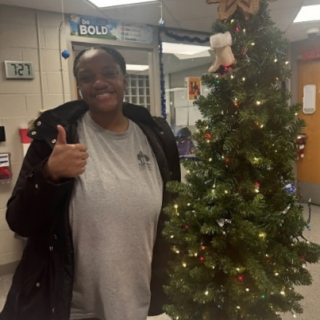On April 8, two days after the death of Rubén Castilla Herrera, the team that supports Miriam Vargas gathered at First English Lutheran Church on the Near East Side. They met to remember Rubén, who started the sanctuary movement in Columbus. Miriam and her family have been living in sanctuary at First English since June.
Miriam was overcome with grief. She met with the team as usual but could only say a few words. “He was like my father,” she said. “He was like a grandfather to my daughters.”
Reverend Sally Padgett, senior pastor at First English, did her best to comfort Miriam. “We’re still here to fight for you,” she said.
The team met again two days later to figure out how to carry on the work without Rubén, who left very big shoes to fill. “Rubén was always texting me early in the morning, asking ‘What to you need?’” Miriam said. “He brought me books in Spanish from the library. He would horse around with my daughter Camilla. He gave me strength every single day. He was my angel. I always told him that. He would always say, ‘I’m just here to help.’”
Miriam came to the U.S. from Honduras in 2005 on a six-month visa. “There was a lot of violence in my country,” she said. “And there was no work. I came here for safety, a better life, and work.” After the visa expired, Miriam continued her life in the United States. She married and had two daughters.
In 2013 Immigration and Customs Enforcement (ICE) caught up with Miriam outside her apartment. “An immigration agent showed me his ID and asked me if I was Miriam, she said. “I didn’t answer, because he scared me. The way his female partner behaved also made me feel afraid. My daughter Camilla started crying.”
The ICE agent assured Camilla that he wouldn’t take her mom. He just wanted to ask some questions. “My daughter calmed down. The immigration officer said that I had to go to the office with them and take my daughter. I was pregnant with my second daughter. They gave me a piece of paper. They took my fingerprints. They told me I had to show up every six months.”
Miriam checked in with ICE every six months for five years, until June of last year, when the deportation order came down. All of the petitions her attorney had submitted had been denied.
“That’s when Rubén started visiting me and helping me,” Miriam said. Rubén took Miriam to meet Edith Espinal, who has been living in sanctuary at the Columbus Mennonite Church. “She told me how difficult it is to live in sanctuary,” Miriam said. “But she told me, ‘You can do it. Don’t be separated from your family. Your voice has validity. And Rubén is going to help us. He’s going to lift our voices.’ And he has.”
Miriam’s face lit up behind her tears when she talked about Rubén. “I met a great person who left a legacy, not only in the community, but also with me, my family, the whole group of people whom we share,” she said. “I learned how to love him, and he loved my family. I’m always going to remember him. He left a legacy that I have to learn.”
Two weeks later, Rev. Sally Padgett reports that Miriam is already learning that legacy. “Rubén left a really big hole to fill,” she said. “But I think Miriam is understanding that she has to take ownership now and feel empowered to do some of the things that Rubén used to do for her. I think that she’s stepping up into that place of strength, ready to try her own wings.”
Two days before he died, Rubén described the work of the Columbus Sanctuary Collective on the GrassRoot Ohio radio show. Sanctuary is “a decentralized movement, which means that we move as the need and the people take us,” he said. “It’s not hierarchical. The white male model is top-down. We know that doesn’t work for women, it doesn’t work for queer people, it doesn’t work for anyone. The Collective is creating consciousness as it happens, specifically from the impacted community, not from us privileged people. That’s hard to do, because even well-intentioned folks want to tell others what is best. It may be the best thing. But it’s the people who are impacted who need to tell us what’s best. We used to have a chant: ‘No more meetings about us, without us!’”
Both the Mennonite and First English churches coordinate their own teams and operate their own funds for sanctuary. “There’s no centralized way to get involved,” Rubén said. “Non-centralized is not efficient, but we’re not after efficiency. We’re after resiliency and sustainability.”
There are six cases of sanctuary in Ohio. “Ohio and North Carolina have the highest number of people in sanctuary, followed by Texas, which may seem surprising, Rubén said. “It’s not necessarily predicated by the percentage of immigrants in the community.
“We’re living in a very difficult time,” he said. “Today, in the age of Donald Trump, for marginalized people —people of color, queer people, women, refugees — the intensity of fear and discrimination has intensified. We’re living in fear, but the other side of that is it brings an opportunity to being something forward, to do something. Marginalization is nothing new to us. This president has just brought it out in a really grotesque way. He’s talking about what this country actually was founded on: fear of others.”
There’s nothing happening politically to improve the situation for people in Miriam’s situation, Rubén said. “The only things happening are criminalization, detention, and deportation. But what we’re asking of our political allies is to be with us, to show up, to tell Miriam’s story. A lot of the politicians you’d think might help us — Democrats and progressives — are really slow to do that, and hesitate. People who get elected are always thinking about how they can be re-elected.”
So far only two Columbus faith communities have opened their doors to provide sanctuary. “It involves “the transformation of a faith community in having that discussion,” Rubén said. “There’s conflict. Some spaces decide not to and decide to do something else.”
Most of the other Lutheran congregations in Columbus have been divided on whether to engage in the sanctuary movement, Sally Padgett said. But at First English the decision to engage was pretty much unanimous. “We’re a unique church in that we pay about a quarter of our budget. Other churches, organizations, and individuals donate to the church to allow us to do the ministry we do. We are a stand-alone church, but we’re only there out of the generosity of other people.”
Engaging in sanctuary “was a very easy decision for us to make,” Sally said. “We’re the recipients of so much generosity from other people. If it’s something we can do, we’re ready to do our part and give back. And immigration justice is something we feel strongly about.
“We’ve been in the trenches now for ten years,” Sally said. “You just learn that it always seems to work out. We’re just trusting and moving forward. I think that’s where a lot of congregations get stuck. They think of all the things that they could lose, or all the things that could happen. If we did that, we wouldn’t be open. This neighborhood isn’t as bad as it used to be, but there are still shootings and drugs and everything else. You have to live out your faith. The congregation is awesome that way. They’re always ready to get involved and be engaged. It’s been great to see how the community has embraced Miriam.”



